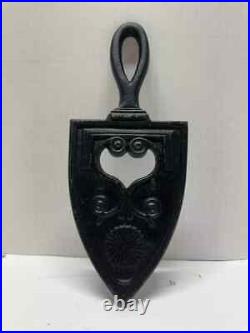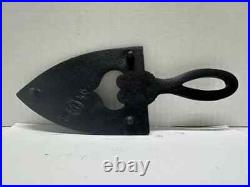


The antique cast iron trivet with heart cutouts in the Victorian style, specifically designed for use with a sad iron, is a fascinating and significant piece that illustrates the intersection of domestic function, aesthetic beauty, and cultural symbolism during the 19th century. Cast iron trivets like this one were essential tools in the homes of the time, serving the practical purpose of protecting surfaces from the intense heat generated by hot irons, pots, and other cooking vessels. However, the design of such trivets was far from purely utilitarian. During the Victorian era, the trend was to imbue even the most functional items with decorative elements that reflected the ornate, detail-oriented aesthetics of the period. This trivet, with its heart-shaped cutouts, exemplifies the Victorian fascination with romantic and sentimental symbols, particularly the heart, which was widely recognized as a symbol of love, affection, and emotional connection. The heart motif was incredibly prevalent in Victorian design, appearing in everything from jewelry and textiles to furniture and household accessories. It symbolized the warmth and affection that were central to the ideals of family life, which were emphasized in the Victorian domestic sphere. In the context of a trivet, the heart cutouts not only add to the visual appeal of the piece but also imbue it with a sense of emotional significance, making it more than just a functional tool for the home. The use of heart-shaped cutouts in the design of this trivet was likely a deliberate choice to reflect the era’s emphasis on sentimentality and domesticity. The heart, as a universally recognized symbol of love and care, would have resonated strongly with the values of the Victorian household, where home and family were at the core of daily life. The trivet’s design was not just about practicality but also about creating a warm, inviting atmosphere in the home, underscoring the emotional and nurturing roles that women often played in maintaining the domestic space. The trivet was specifically designed for use with a sad iron, a type of flat iron that was heated on a stove or in a fireplace rather than using electricity, which was not yet widespread. Sad irons, named for their heavy weight (“sad” being an old term for “heavy”), were typically made of cast iron and would have required a trivet to provide a safe resting place when not in use. The sad iron was an important tool in the home during the Victorian period, as ironing clothes was a labor-intensive task that could take up a significant portion of the day. The heavy iron would be heated on the stove and used to press clothes, requiring a trivet to rest the hot iron between uses. The practicality of the trivet was inextricably linked to the aesthetics of the period, where even the most mundane items were expected to add beauty to the home. Cast iron trivets, like this one, were common in many Victorian households, and the combination of function and ornamentation made them cherished items. The heart cutouts on this trivet were likely formed through intricate casting techniques, where molten iron was poured into molds to create detailed designs. The raised edges of the trivet would have provided stability, ensuring that the hot sad iron was safely supported and did not come into direct contact with any surface that could be damaged by its heat. This form of craftsmanship, combining both beauty and utility, reflects the broader trends of the time, where artisans and manufacturers sought to create household goods that were as decorative as they were functional. The choice of cast iron as the material for this trivet speaks to the Industrial Revolution and the advancements in mass production techniques that allowed such items to be made more widely available to the public. Cast iron was durable, heat-resistant, and relatively inexpensive to produce, making it the ideal material for everyday household items such as trivets, stoves, and cookware. Despite the industrial nature of its production, the attention to detail and artistry in the design of this trivet sets it apart from more utilitarian objects, allowing it to serve as a decorative accent in the home as well as a functional tool. The Victorian style, with its love of intricate patterns and symbolic imagery, would have made this trivet a prized object in any household. The use of heart-shaped cutouts also ties this piece to broader trends in Victorian furniture and home decor, where nature-inspired motifs like hearts, flowers, and scrolls were commonly used to convey romantic and sentimental ideals. These motifs were meant to evoke feelings of warmth, affection, and love, qualities that were highly valued in the Victorian era, especially within the context of the family and home. As a decorative object, the trivet would have likely been displayed when not in use, serving as a reminder of the Victorian appreciation for beauty in everyday life. The sentimental nature of the heart design made it a fitting addition to a home, where decorative objects were often meant to convey the personality and values of the household. The trivet was not merely an object to be hidden away but was a piece that could be displayed proudly, contributing to the overall aesthetic of the domestic space. Today, the antique cast iron trivet with heart cutouts serves as a tangible connection to the past, offering insight into the domestic life of the Victorian era. It highlights the period’s unique approach to household goods, where every object, no matter how small or practical, was expected to contribute to the overall beauty and emotional atmosphere of the home. As a collectible, this trivet holds historical and aesthetic value, appealing to those with an interest in Victorian decor, cast iron antiques, or domestic history. Its heart-shaped design and the symbolism it carries continue to resonate with modern collectors, who appreciate the craftsmanship and sentimental significance embedded in the object. The trivet remains a testament to the enduring influence of Victorian design, where the home was not just a place of refuge but also a space where beauty, love, and sentimentality were cherished and celebrated. In summary, the antique cast iron trivet with heart cutouts is a prime example of Victorian craftsmanship, where functionality meets artistry in the domestic sphere. Its heart motif speaks to the era’s emphasis on love, affection, and the nurturing role of the home, while the cast iron construction and careful detailing reflect the period’s industrial advancements. As both a practical tool for use with a sad iron and a decorative object, this trivet continues to offer historical value and aesthetic appeal, standing as a reminder of a time when even the most everyday items were designed to inspire warmth and beauty in the home.

